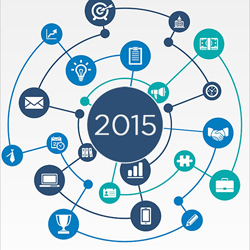The Top 7 Marketing Trends for 2015
Where are marketers’ biggest opportunities this year?
 Big Data, personalization and precision targeting are trends to watch in 2015.
Big Data, personalization and precision targeting are trends to watch in 2015.It’s interesting to think just how far marketing has come since I began in the business more than 30 years ago. If I had tried to describe 2015 then, I don’t think I’d have done much better than Back to the Future II.
That’s why you don’t see many prognosticators predicting trends decades from now, much less 10 or even five years. One year’s a safer bet. Eagle-eyed marketers can spot new trends emerging months before they gain critical mass, and use it to their advantage.
Many of the trends we highlighted in last year’s blog post are still going strong: mobile marketing, branding, integrated marketing – so this year’s may look familiar. Visual marketing continues to be important as businesses fight for their share of fragmented attention spans. Mobile isn’t going anywhere (with a few new developments we’ll discuss), and businesses will keep producing useful content to provide more value to their customers.
Now let’s look at what’s new for 2015.
1. Organic Search – Not What It Used to Be
Organic search listings continue to get pushed farther down the page, as search engines seek to maximize revenue from paid advertising. Many marketers will take this as a cue to invest more heavily in paid search marketing, which will require a larger focus on campaign optimization.
And Google’s recent updates to its search algorithms have made it next to impossible to game the system with old SEO methods like keyword stuffing or creating hundreds of inbound links from low-quality websites. To achieve high rankings in organic search results now requires frequent updates to your website with original and engaging content that’s written for your customers, not googlebots.
2. Data-Driven Marketing Becomes the Norm
There’s never been as much information available about how consumers act online – what’s now known as “Big Data.” And marketers have begun to embrace statistical analysis to stay ahead of both consumers and competitors.
Website analytics, email metrics, first- and third-party data all combine to create an impressively detailed picture of your prospects. Marketing automation tools make it easier to personalize marketing messages and reach those consumers at the right time, across media channels. Digital ads can target ever more granular audiences by leveraging data on geography, demographics, behavior, interests and preferred mobile devices.
Which is why …
3. Hyper-Targeted Advertising Gains Momentum
The buzzword for 2014 was “programmatic,” a system that combines automated ad buying with highly targeted digital ad placement. Programmatic buying is all about precision, resulting in a more efficient use of advertising dollars than the usual process of purchasing digital ads manually through various ad networks.
In general, targeted ads and personalization will continue to grow as the mountains of consumer data let businesses send more and more relevant messages.
4. Social Media Keeps Evolving
Social media channels are constantly devising new types of advertising, both to apply new technologies and stay a step ahead of jaded users. That spells opportunity for marketers. Even platforms like Tumblr and Snapchat – big with Millennials who are wary of marketing – are getting into the ad game. For 2015, marketers will look beyond the standard sponsored ads on Twitter and Facebook and find new, creative ways to interact with their customers through social media.
5. News Media Makes a Comeback
By now it’s accepted wisdom: newspapers are dying. But that’s not entirely true. While print readership is in decline, media companies long ago began migrating their content online.
More recently, savvy newspapers have realized their unique strength lies not just in their large and loyal audiences, but in the data they produce. In addition to regional or local reach, marketers can target more and more specific audience segments based on the content they consume. And newspaper readers now get most news via mobile devices – a terrific opportunity for advertisers who need to connect with audiences on the go.
Which brings us to …
6. Mobile is Still on the Move
The fact that mobile usage outpaced desktops in 2014 is probably no surprise. Mobile search is predicted to surpass desktop search in 2015, too. And that growth won’t stop at just smartphones and tablets.
Wearable technology like the iWatch will find its footing this year, leading marketers to test ways to make the best use of these new platforms. (This will have a big effect on brick-and-mortar, too, as mobile payment systems like ApplePay take off.) Add in the “Internet of Things” – everyday objects connected to the internet – and the possibilities are limited only by marketers’ imaginations.
7. More Human Brands
Today consumers expect more from brands, particularly aging Millennials. Like real-time customer service on Twitter. Accountability and sustainability. Novel experiences or useful tools that enrich their lives. Brand values they can relate to, and companies that are responsive, not empty marketing speak.
Authentic brands are no longer a positioning gimmick, they’re a necessity. (I would argue this has been the best position to take all along.) Both good and bad brand experiences are quickly amplified across the internet, and it’s getting harder to avoid real human-to-human interactions.
Conclusion
In general, marketing in 2015 will be marked by ever-fading lines between marketing channels. The technologies that make this possible will take center stage, helping marketers tell more cohesive brand stories (and at the same time more personalized), everywhere their customers are. And thanks to today’s skeptical, connected consumer, those stories will have to be rooted in transparency and authenticity – your customers will see through anything else.
Pingback: For Effective Marketing, Take More Creative Risks